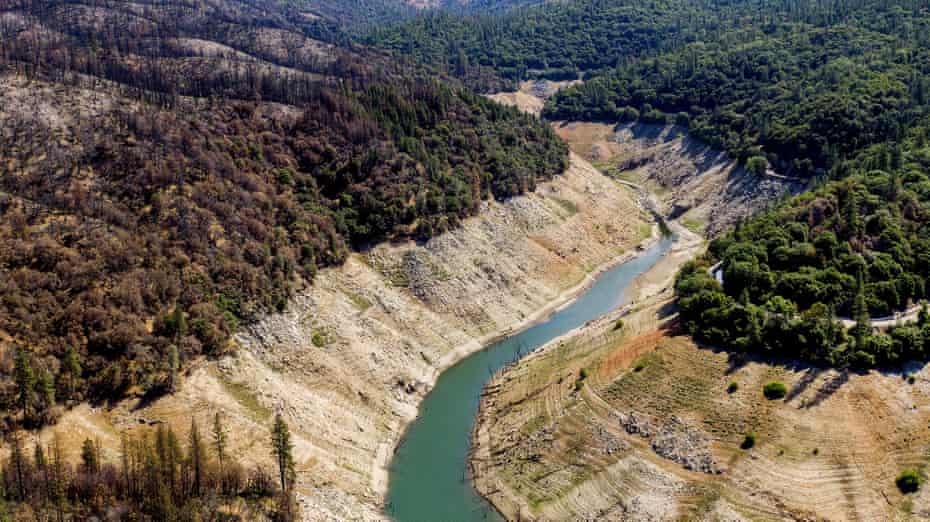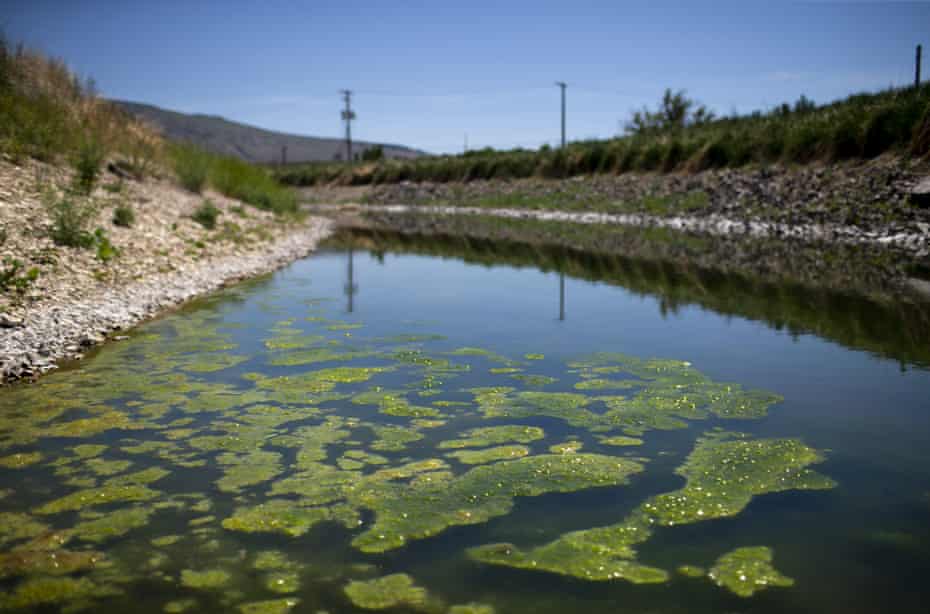Just two years after California celebrated the end of its last devastating drought, the state is facing another one. Snowpack has dwindled to nearly nothing, the state’s 1,500 reservoirs are at only 50% of their average levels, and federal and local agencies have begun to issue water restrictions.
Governor Gavin Newsom has declared a drought emergency in 41 of the state’s 58 counties. Meanwhile, temperatures are surging as the region braces for what is expected to be another record-breaking fire season, and scientists are sounding the alarm about the state’s readiness.
“What we are seeing right now is very severe, dry conditions and in some cases and some parts of the west, the lowest in-flows to reservoirs on record,” says Roger Pulwarty, a senior scientist in the National Oceanic and Atmospheric Administration (Noaa) physical sciences laboratory, adding that, while the system is designed to withstand dry periods, “a lot of the slack in our system has already been used up”.
How did we get here?
A creeping trend
Drought is not unnatural for California. Its climate is predisposed to wet years interspersed among dry ones. But the climate crisis and rising temperatures are compounding these natural variations, turning cyclical changes into crises.
Drought, as defined by the National Weather Service, isn’t a sudden onset of characteristics but rather a creeping trend. It’s classified after a period of time, when the prolonged lack of water in a system causes problems in a particular area, such as crop damages or supply issues. In California, dry conditions started to develop in May of last year, according to federal monitoring systems.

The effects really began to show in early spring 2021, when the annual winter rainy season failed to replenish the parched landscape and a hot summer baked even more moisture out of the environment. By March, conditions were dire enough for the US agriculture secretary, Tom Vilsack, to designate most of California as a primary disaster area. Just two months later, 93% of the south-west and California was in drought, with 38% of the region classified at the highest level.
“When you have droughts with warm temperatures, you dry out the system much faster than you’d expect,” says Pulwarty, adding that climate change can make droughts both more severe and harder to recover from. “It is not just how much precipitation you get – it is also about whether or not it stays as water on the ground.”
Dwindling water, rising temperatures
The state’s previous drought lasted roughly seven long years, from December 2011 to March 2019, according to official estimates. But some scientists believe it never actually ended. These researchers suggest that the west is gripped by an emerging “megadrought” that could last for decades. A 2020 study that looked at tree rings for historical climate clues concluded that the region may be entering the worst prolonged period of drought encountered in more than 1,200 years and attributed roughly half of the effects to human-caused global heating.
Meanwhile, California has been getting warmer, and 2020 brought some of the highest temperatures ever recorded. In August of last year, Death Valley reached 130F (54C) and a month later, an area in Los Angeles county recorded a 121F (49.4C) day – the hottest in its history.
Heat changes the water cycle and creates a thirstier atmosphere that accelerates evaporation. That means there’s less water available for communities, businesses, and ecosystems. It also means there will be less snow, which California relies on for roughly 30% of its water supply.
“The snowpack, in the context of the western US and specifically in California, is really critical for our water supply,” says Safeeq Khan, a professor at University of California, Merced, who researches the climate crisis and water sustainability. “The snowpack sits on the mountain and melts in the spring and early summer. That provides the buffer to overcome the extreme summer heat,” he explains.
But in recent years, even during wet winters, he says, the snowpack wasn’t as strong as it used to be. This year, even before the summer, it is already nearly gone. The melt has also produced less runoff than expected, meaning less trickled into streams, rivers and reservoirs.
“Years like this, when we do not have the snowpack, it really puts our water system under tremendous pressure,” Khan says. He doesn’t think that will change anytime soon, adding that, while drought isn’t new in the west, “the kind of drought we are experiencing is new. The impact is a lot more than it was in the past.”
What will the impact be?
Drought disasters are among the most costly, according to the US National Centers for Environmental Information, running an average of $9.3bn in damage and loss. Dry conditions are also expected to fuel another potentially devastating wildfire season. In 2020, roughly 4.1m acres were consumed by the flames, tens of thousands of buildings burned and 31 people lost their lives.
The browning hillsides and dying trees are not only increasing the risk of ignitions, they also cause fire behavior to be more extreme when blazes erupt, according to Scott Stephens, a fire ecologist at the University of California, Berkeley. “We’ll probably get to typical fire season moisture levels six weeks early this year because of the drought,” he said as part of an interview series for the Public Policy Institute of California.
Along with wildfire risks, short water supply is putting immense pressure on the state’s agricultural industry, which grows over a third of the country’s vegetables and supplies two-thirds of the fruits and nuts in the US. Already farmers are culling crops and fallowing fields in anticipation of water shortages. Karen Ross, California’s food and agriculture secretary, told the California Chamber of Commerce that she expected 500,000 acres would have to sit idle this year.

The federal government has already announced a dramatic reduction in water allotments to farmers in California’s Central Valley, while further north, tensions are running high in the Klamath Basin, where a federal canal servicing 150,000 acres of farmland will run dry for the first time in 114 years.
Cities and other urban regions are also set to receive less water, and residents are being asked to conserve where they can.
“We are truly in an emergency situation,” Rick Callender, CEO of the Santa Clara Valley Water District, which delivers water to 2 million residents south of the San Francisco Bay Area, told the Mercury News last week. The agency will enact mandatory restrictions across the county, adding that the public should anticipate cutbacks to increase as the situation intensifies. “We’re going to be seeking everything we can do to address this emergency.”
Worsening drought will also exacerbate longstanding problems for people in the Central Valley, who have suffered through shortages in water for drinking, cooking and sanitation. During the previous drought, wells ran dry and never recovered. More than a million Californians still don’t have access to safe drinking water.
Low water levels also have the potential to affect the state’s electrical grid, which depends on hydroelectric power plants, the Los Angeles Times has reported. Lake Oroville is expected to fall below 640ft – the level state officials say is required to run a plant – by August. Currently, it stands just above 700ft.
How ready is the state?
California has already invested billions to prepare and has learned key lessons from the last round, when the state experienced its driest four-year stretch in history. In 2014, the state also passed the Groundwater Management Act, landmark legislation that requires communities to monitor groundwater basins and develop plans to protect them. But implementation is still in its early stages.
Newsom has proposed a $5.1bn investment over the next four years to respond to the disaster and improve infrastructure. Cal Fire, the state’s firefighting agency, has also added 1,400 new firefighters to its ranks, along with picking up new helicopters and fire engines.
“California has done a remarkable job,” says Pulwarty, but he adds that more ambitious solutions are still needed.
“There are innovations that we need to scale up,” he says, from urban conservation and reuse to upping agricultural efficiency and creating land reserves that will help regions become more resilient when drought disasters strike.
Others warn the state must take the long view, with drought conditions likely to get worse before they get better.
“If we are worried about this year we are really playing the short game,” says Doug Parker, the director of the California Institute for Water Resources. “It’s next year that I think is more important.”
The water system, he says, is designed to handle short-term shortages. “When you get into three, four, five years in a row of drought – that’s when things really start to get serious. We all wish we knew what was going to happen next winter.”